Now I don't give two shites about whether they want to hunt or not, but the 'surveying' is flawed.
I do know that most of the 'surveying' was done by local DCR rangers with little to no experience in counting deer populations. Yes DFW signed off on it and were there. But three nights of approx 4-6 hours per night, to cover 7000 acres? No way.
As many know, I've traveled the Blue Hills end-to-end many days and nights and I'm lucky to see one deer each time. Once in awhile Ill see a pack of 8-10 but thats it.
AND, I've only EVER seen ONE deer on BUCK Hill, and yes, it was a BUCK!
Like I said, I don't really care either way, but I'm SURE there are not 850 deer in the reservation.
I just don't appreciate being told that this is going on without full comment from and consideration of the public and THEIR NEEDS. What THE PUBLIC needs are COMMUNITY ACCESS TRAILS from Braintree and Quincy so people of those towns can ride mountainbikes through the no-no section over to the trails on the west of rte 28. The rules why the east side is prohibited are vague--anything from scared horse riders to endangered snakes to hikers who may want an experience untainted by an occasional friendly bike rider. OK thats it for now. Welcome back to MountainBikeChurch! :-)
Read on ( and please, read the whole plan when if you have time):
The following is an excerpt from http://www.mass.gov/eea/docs/dcr/news/public-meetings/materials/parklands/blue-hills-deer-management-plan.pdf
1.3 Deer Abundance Surveying in the Blue Hills
In early May of 2013, DCR worked collaboratively with DFW to conduct a white-tailed deer abundance survey in the Blue Hills Reservation at the request of the Friends of the Blue Hills. The goal of the survey was to estimate (using quantitative methods) the density of deer per square mile within the Reservation. Using distance sampling as a survey method, two crews of DFW and DCR staff gathered observations and data over the course of three nights for approximately four to six hours each night. The survey was conducted along a representative sample of available roads and trails within and around the Blue Hills Reservation and 14 survey routes (or transects) of similar lengths were identified. Both paved roads and dirt trails in areas considered deer habitat were used. As such, about 80 percent of the study area was forested and/or shrubland and considered to be deer habitat.
Following the physical collection of data, DFW staff performed statistical analyses of the information using
several models and methods. Based upon the results of this analysis, DFW estimated (conservatively) that
there are about 85 deer per square mile of deer habitat in the Blue Hills. It is important to reiterate that this
density estimate is believed to be conservative and that the actual deer population density is likely higher.7 For
additional details regarding the population survey and data analysis, readers are strongly encouraged to review
DFW's technical report developed and published by David P. Stainbrook, DFW Deer and Moose Project Leader .8
Given the results of the population survey and the density estimates produced, it is very clear that deer densities in the Blue Hills are well above DFW's statewide deer management range of 6 to 18 deer per square mile of forest. In addition, DFW’s technical report also noted (citing Tilghman 1989,9 and Horsley, et al., 200310) that this density estimate for the Blue Hills exceeds the threshold density of 18 to 20 deer per square mile of forest where negative impacts become evident in northeastern forests.
Given the results of the population survey and the density estimates produced, it is very clear that deer densities in the Blue Hills are well above DFW's statewide deer management range of 6 to 18 deer per square mile of forest. In addition, DFW’s technical report also noted (citing Tilghman 1989,9 and Horsley, et al., 200310) that this density estimate for the Blue Hills exceeds the threshold density of 18 to 20 deer per square mile of forest where negative impacts become evident in northeastern forests.

